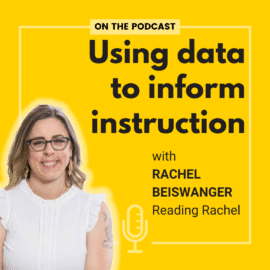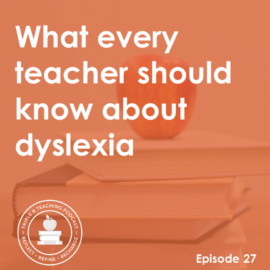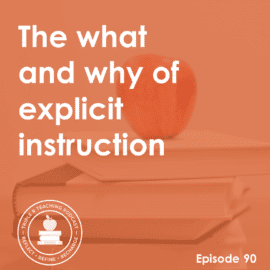TRT Podcast #124: How to fit phonemic awareness into your phonics lessons
This week I’m doing a hot topics collaboration with Melissa & Lori Love Literacy … and it’s all about phonemic awareness! Learn how to fit phonemic awareness into your phonics lessons, and then head over to Melissa & Lori’s podcast on Friday to hear an interview with Heggerty’s literacy consultant.
Full episode transcript
Hello! Anna Geiger here from The Measured Mom, and this week I'm going to talk about phonemic awareness and how to fit it right into your phonics lessons.
As you know, that's been pretty spicy in the last couple of years in the science of reading community. There's been a lot of discussion, you might even call it infighting, that has unsettled some people. I think it's good to remember that as members of a scientific community, we expect that what we know will change over time, and that's okay.
We're going to talk now quickly about phonemic awareness in your phonics lessons, but before we do that, let's break down again what phonemic awareness is.
Phonemic awareness is the conscious awareness of individual sounds in words. For example, the word rake has three phonemes, /r/ /ā/ /k/, even though it has four letters. The word strength, which has eight letters, has only six phonemes, /s/ /t/ /r/ /ĕ/ /ng/ /th/.
This conscious awareness of sounds is something that we need to teach. The question is how do we teach it? That's where a lot of the controversy has come about.
For many years, we were taught phonemic awareness activities can and should be done in the dark because phonemic awareness is an oral skill. However, we've known from research, for quite a few years actually, that phonemic awareness activities are more powerful when combined with letters. Some people have thought, oh, if you add letters, then it turns into phonics, but that's actually not true. We can combine the two.
So I recommend starting your phonics lessons with a brief phonemic awareness activity connected to the sound of the grapheme you're going to teach. If you're teaching your students that C-H spells /ch/, I would start with an oral-only activity just to get students' ears listening to that phoneme, becoming aware of it. This would be an example of a time where I think an oral phonemic awareness activity makes sense.
If I'm teaching that C-H spells /ch/, I could start like this, "Okay, students repeat these words after me. Chip, chill, Chad, chart, chin. What sound did you say at the beginning of each of these words? That's right, /ch/."
Now you might have little mirrors. Some teachers do this where they have kids pull out little mirrors so they can look at what their mouth is doing when they make a particular sound. I could say, "Take out your mirror. What's your mouth doing when you say /ch/? What are your teeth doing? Put your hand in front of your mouth. Do you feel any air coming out?" or "Put your hand on your neck. Do you feel a buzz when you say /ch/?" And you wouldn't because /ch/ is an unvoiced sound.
Then I could move on. We could do some phoneme blending activities. I could say, "I'm going to say some sounds and put them together to make words. My sounds are /ch/ /ĭ/ /k/. The word is chick. Now, it's your turn. I'll say the sounds, and when I put my hand in front of me like this, say the word together." Just imagine I've got my hand outstretched to the left, my palm facing me, and I move my hand away from myself for each phoneme, and then I place my hand palm up as a signal for the students to say the actual word. I would go, /ch/ /ŏ/ /p/. I wait a second or so, and then when I put my hand palm up, the students could join together and say, "chop". I would do that with a few other words like such, rich, and chug. That would be enough. That's only a couple of minutes, but that's a really good introduction to my phonics lesson.
Then I could say, "The /ch/ sound is spelled with the letters C-H," and then I could connect it to my sound wall, if I use a sound wall, by revealing the C-H spelling. Then I can move into the rest of my phonics lesson, having them read words with ch, having them read blending lines, reading connected text, doing dictation, and so on.
Another way, a very important way, to include phonemic awareness in your phonics lesson is by doing phoneme grapheme mapping and also word building.
You're probably aware of phoneme grapheme mapping, that's been very popular for a while now, but it's this idea of using sound boxes, and then putting the spelling in each box. What you could do is you could have a piece of paper in front of your students with four or five boxes in a row. They're probably only going to need three boxes, but you know it's good for them to have to think about how many they need.
For example you could say, "We're going to segment the word chop, take the chips that you have and move a chip into a box for each sound. Ready? /ch/ /ŏ/ /p/. How many sounds? Three, correct. Now, let's spell each sound."
Then you could have them move those little counters out of the way, and they could write with pencil. You could be doing this on a dry erase board, or they could be using letter tiles. If you have letter tiles, of course, you only want a single sound represented on each tile. They would use a tile that says CH, not the C and the H, the CH tile. Then they would spell each sound using those tiles or writing the letters.
After that, you'll have them put their finger under the word and move it to the right as they blend the sounds to read the word. "Let's say the sounds of that word, /ch/ /ŏ/ /p/. Now, let's blend them together, chop."
So right there we've done phoneme segmenting and blending, right in our phonics lesson. Of course, we wouldn't stop with one word. We'd do a number of words.
As we're doing this, we could also be working on phoneme manipulation. I could say, "Okay, we've done the word chop. What would you have to do to change the word chop to chip?" And then some of them would tell you to move the O out and put in the I, or they would say, change the /ŏ/ to /ĭ/, or you could just tell them what to do. After you've got the word chip, you can say, "Okay, change the /p/ to /n/. Now, read the word." Right there, they've done phoneme manipulation and blending.
As you can see, including phoneme grapheme mapping and word building activities in your phonics lesson is a fabulous way to build phonemic awareness, because phonemic awareness should not be an end in itself.
We don't want to do scads of oral activities in the hopes that that's going to bring our kids to a certain level. Dr. Jeannine Herron has said that phonemic awareness is best learned by pronouncing spoken words and segmenting them in order to spell them, which is exactly what you're doing with the activities that we talked about today.
Thanks so much for listening! You can find the show notes for this episode at themeasuredmom.com/episode124. Talk to you next time!
Sign up to receive email updates
Enter your name and email address below and I'll send you periodic updates about the podcast.








Nicolette Poindexter
Love This! I am teaching Pre K this year this is helpful.
Heather Groth, Customer Support
We’re glad to help!
nur
oh sorry 🙁 ı’m a Turkish and a little; a bit speak english :(( My Bad 🙁 I couldn’t understand what you said 🙁
Donald Knight
Short and powerful!!
Anna Geiger
Thanks so much for listening!